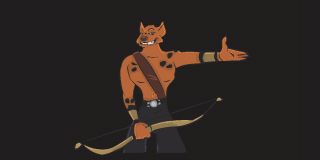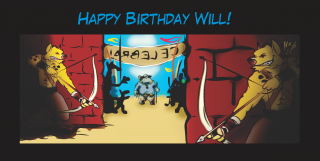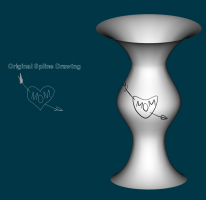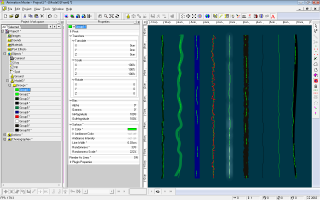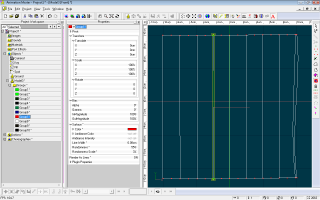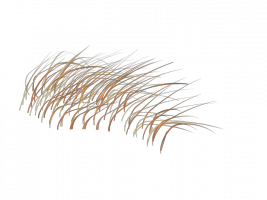-
Posts
21,630 -
Joined
-
Last visited
-
Days Won
114
Content Type
Profiles
Forums
Events
Everything posted by Rodney
-
Very innovative Robert. Kudos to you for demo'ing this. I know I'll be able to use it.
-
I couldn't resist trying to draw this guy again but a little closer to your model. Apologies for the liberties I've taken. When drawing this I was thinking 'saturday morning cartoon'...
-
Thanks Will. Just in the short time I was drawing this I was really liking the idea of seeing your characters animated. (Their actions were playing out in my mind at least but I didn't have the stamina to draw 12 hyenas encircling Tar at a birthday feast!). Those hyenas alone will make really fun adversaries. If nothing else 3D modeling should make it easier to duplicate them!
-
I see Mr. Zandoria Studios himself is having a birthday. Happy Birthday Will. Hope it's a great one! The story behind this drawing (or at least what I think might be going on here: Tar has just saved this village from their cruel and nasty king and the people have come out to celebrate. Tar is (as is his nature) very suspicious but after being fed and entertained begins to think that people appreciate him. Little does he suspect that the village leaders have hired assassins to rid themselves of Tar, whom they see as just another threat. The assassins are all too happy to take on the job because at last they'll be able to be rid of Tar themselves. The very last page of this (imaginary) comic book reveals Tar resolving the crisis and then suddenly realizing this day was his birthday. He thinks, "all in all, not a bad birthday." Happy Birthday Tar. Happy Birthday Will!
-
I assume that Disney may no longer be asking Bob Iger to leave in a year or so? He seems to have done pretty good for them since they said he'd be hitting the road.
-
Is this April 1st? http://animationguildblog.blogspot.com/201...-lucasfilm.html and from another source: In other news (NY Times/LA Times etc.): George is retiring (with Kathleen Kennedy taking over as head of Lucasfilm) Disney is to pay $4.05 billion for Lucasfilm. Included in the deal are special-effects house Industrial Light & Magic, Skywalker Sound and video game company LucasArts.
-
Yes, I did. Then, I lost the pen. But I found my previous pen! Then, I lost that pen. Granted this last one was during a move from the other side of the world but after I put it in a place intentionally so it wouldn't get lost, that's frustrating. I didn't know what that was so I had to look it up. I see that some people had issues with Protexis and uninstalled it. (But those references were from 2009-2011 so I'm not sure if its there currently). If it is, I've never noticed it. Here's the write-up on removing Protexis: Emphasis added. I recall being very frustrated with the earlier tracer in Coreldraw because it tried to group things that I didn't want grouped. What a pain that was. The current tracer not only doesn't do that but it has options that the earlier version did not. You can also dial in the level of detail which I usually want to crank way, way up. I'm guessing there is a place to set that as as default but I've been too lazy to find out so I dial that detail level up each time I trace a drawing. One thing that I use a lot that I didn't know I needed before was the setting to automatically drop out the background. It doesn't always get all of the background because it needs to interpret what that actually is and that can be tough in a complex drawing... but amazingly, it usually does.
-
I'm sure there is. Some of those we can probably do right now... we just don't know how to do that already. Yesterday I also tried a cracked glass look but I didn't think it was worth posting. Patches will always be more powerful for getting splines into 3D space but RAL does have some nice uses. I think RAL would need a major rewrite to take advantage of anything much more significant and that'd be a particularly expensive endeavor given that few use it. I read a tech paper not long ago that suggests a way we could fake some of the more powerful RAL stuff by creating the framework ourselves and because with A:M we can often create our own solutions I may just give that a try. There is one aspect of the current RAL that keeps it from being of practical usage in my work and that is the ability to taper the ends of the line. But for this it's fairly easy to just change to patch geometry (see above example all the way to the right). The one tool that I've found to be of most use with RAL is Snap Group to Surface because with that we can get any and all of our splines to conform to an object's surface. The secret to Snap Group to Surface is Named Groups. Just name a group of splines, position it in front of the object you want to have the splines conform, right click and SGSNG! Once in place the easiest way to get tapered lines is to use Sweeper to add tapered geometry to those lines. Added: This isn't hair but follows the same principle of Geobased Hair. What I think is particularly interesting about it is how that we can decal objects with geometry rather than graphics. Note: I don't think we can Snap Group to Surface in a Chor. If we can then we can do those fancy things where objects can appear all over the surface of an object in a few short steps.
-
Thanks Mike, A:M makes it fun to experiment. Here is a test I did today with Render As Lines. All of the splines here are straight lines exactly identical except the last one on the right (which is two lines that form a patch) It's interesting to see what shows up just with adding a new level of detail via a new Named Group.
-
Ken, Thanks for the info. That helps me keep everything in perspective. I've talked with several people that just have a hard time using Corel... they see it as complex and difficult to use... I on the other hand after all this time have easily forgotten how much time it took me to get comfortable with it and because of that can't understand why others struggle with it. "Isn't it easy to use", I say. Well, no. It probably isn't. In drawing programs I've used many different ones ranging from the more expensive and complex to the cheap and entirely too simple. I usually prefer the programs with utter simplicity because they focus on doing one thing well but their quality and compatibility with other products can also suffer there. I've used Manga Studio but found that (short of the zip-a-tone features) I've been able to produce better results elsewhere. My memory says that there were other incompatibilities that restricted my workflow in significant ways. For instance, I like to use the clipboard every chance I get and programs that don't play nice with the clipboard aren't likely to impress me. Interestingly, the one exception I can think of is Animation:Master which saves almost nothing to the Windows clipboard. Go figure. In order to take full advantage of a drawing program the artists really needs to be able to use a pen. That drawing of the fox... I drew and colored with my finger on the 2x2 (or 2x3... I've never measured it) touchpad thingy on my laptop... definitely not the best way to draw an image! I really like Toonboom Animate's ability to cut the excess/unwanted ends off of lines. That is a great feature that I wish we'd see in other programs. The historical equivalent of doing the same thing was to use white paint to quickly cover or outline shapes. I am a huge fan of rapid drawing techniques. Why draw only one image when in that same amount of time you can draw ten of the same quality.
-
Awesome news! Congratulations!!!
-
Yes, that second one really pulls you in. I think having some variable speed (ease in/ease out?) going into the corners would be nice as that would not only give a sense of acceleration but also allow the viewer to see more of the tunnel they are in. As a suggestion perhaps you could stretch out the over all length (doubling the duration) but then accelerating through the straightaways. Nice work John!
-
That is looking nice! I have a thought that might not be valid but I'll offer it up anyway... It seems to me that the bursts of 'pre-snow' that the candles shoot up into the air could be brightly colored instead of white. As it is I get a mild sense of 'I don't really know what is going on here.' In this way you'd have a transition from colorless setting to colored candles to that of color being shot off screen. This might even result momentarily in people thinking, "Oh, cool. Neat sparklers," only to have the transformation of the snow occur off screen in the imagination of the viewer as the falling white snow enters the scene and transforms the whole world into a winter wonderland of color. I think you could do this with just simple tinting color (either as a patch or something of a post effect via after the Effects) place over the 'sparklers' as they shoot up into the air. What this would give would be a sense of celebration (at the candles) that changes/transforms as everything is transformed by the magic of the season. I'd leave a hint of white in the coloring prominent enough to maintain a solid link with the snow itself. I don't know if you are planning any additional foley effects but a 'ding' as each of the objects transforms into their colorful personas might also strengthen the effect of change. It'd also be an echo to the general use of bells and chimes of the season. All this just for what it's worth. This is very creative stuff Gerry. Impressive work on display. Edit: In rereading my post I see that I'm not entirely clear in my description. I think if you play 'track the color changes throughout the entire sequence' and how each element anticipates and motivates the next transformation it might be clearer what I am trying to say.
-
This is great news. Now everyone can give A:M a try.
-

It was a dark and stormy night.
Rodney replied to Simon Edmondson's topic in Work In Progress / Sweatbox
Thanks for the explanation Simon. I figured it was a stylistic choice but was interested in hearing your take on it. You are close enough to having those characters look 'normal' that I'd like to see you push them the rest of the way there or push their stylistic appearance further to exploit what you've already got going here. Lest you think I just don't like the thinness of the characters at all, it might be good to know that I've long had some characters that have some similar thinness to them (mostly in the arms) but the design is built on (what I consider) a plausible reason for that thinness to be there. In my case however the characters are actually stickmen but there is a reason for them to be stickmen in a world where they can interact with real humans. In short, they were manufactured that way via nanotechnology and they have become (effectively) sentient beings. I use to have a few images here in the forum with them... in a topic titled, 'My Robot Movie' but the links broke when I moved years ago. I called that team of them, 'Team Megamatchstick' so technically they weren't stickmen but rather matchsticks. The closest thing I can compare them to might be 'The Micronauts' if you are familar with them. Some day I'd like to to revisit those characters... and I do think they have a plausible thickness to their chest and stomach areas even though they are otherwise very unnaturally shaped. For my part I'm trying to understand my own reaction to your character which has been, "Why don't these normal looking characters have a chest and a stomach?" versus "Hey, those are some cool looking stylized characters." I confess that I don't know why this is but that has been my general reaction each time I see them. Consider the following and perhaps it'll make some sense: Let's say one of your characters had a piece of clothing that hung down over their shoulders (a poncho or a vest or something similar). Would that clothing hang down naturally into the air (the missing space where the chest and stomach would be or would it conform to the shape of their abstract chest and stomach? I can anticipate your response as saying, "It'd hang down normally as if gravity were effecting it." Of course I might be wrong here. If it'd hang down normally then I again would question why the chest and stomach are missing. I suppose what I am saying here is that if this abstracted style is the norm then something in their environment should echo that stylistic abstraction. Perhaps vases on a table would be unnaturally thin in the middle. Trees might be entirely too in their middle section. Common items around the house such as a full sized mirror or window might repeat that shape. In a Lego world one of the things that makes it so compelling is that the basic shape is repeated through everything and that provides the glue that forms a plausible reality (and a suspension of disbelief). Others may not have any issues with your current abstraction but for me it remains one of 'Why can't he see what is obviously wrong with these characters and just fix them?" I hope this is making sense. I'm not suggesting you alter your character to conform to something you don't want or intend. I'm just trying to make sense of them myself and their odd middle sections are growing on me. And I can immediately recognize your characters and distinguish them from someone elses. Perhaps you can explore that stylistic approach, push it further and take advantage of it. -
Glenn hasn't posted in awhile... and he is missed. He's the guy behind a few utilities that I use to use a lot: Render Done and Library Manager. Showing newbies like me how we can program cool stuff for use with A:M with programs like AutoHotKey and/or Autoit. Happy Birthday Glenn. Hope you have a happy one! Added: Glenn is also the author of the first successful two sided/decaled patch: '2 sides to every cloth' I was never patient enough to figure that one out.
-
Everyone has different experiences I guess. While I've not been a big fan of the various other offerings from Corel, I've had very good experience with Coreldraw and Photopaint. I prefer them to Illustrator and Photoshop. I'm not questioning your experience here so don't take it that way. I'm just wondering why your experience is so different from my own. What has me stratching my head the most is the following: I've never ran into that problem. Well, maybe way back in v7 or so when very few companies had their registration process working perfectly. My memory might be faulty but I'd say that since at least v11 all I've ever had to do is enter the registration code and submit. My memory says that actual registration on the site itself was until very recently optional. I register because I like them to know that I'm here. Almost every file format offered by a major vendor is proprietary. But that's why there are other formats that can be saved or exported to. On the Photopaint side there is Photopaint's native file format (.CPT) which is their version of Adobe's .PSD. If I think I won't ever need to use the file elsewhere this is the best format to save to because it saves everything. If I do think it'll be used somewhere else then I still try to save a CPT file first and then resave it or export it to the desired format later. The reason why we (or anyone for that matter) should use a program's proprietary format is that other formats often don't support elements that are saved in that program's own format. To save to another format means loss of data (unintentionally or otherwise). So proprietary is a plus in this regard and not a negative. It's also a good reason to support native file formats in an age of open file formats. Where proprietary gets ugly is where you can't export to other formats (which is a breach of communication as well as software etiquette. Corel doesn't have this problem as it supports all the standard file formats. I would love to see more information on this because accurate tracing is important. I've yet to see a tracer that gives me better results than Corel Trace as that feature has been important to me. In fact, its accurate enough that I routinely work back and forth between Photopaint and Coreldraw in order to simplify my work (Paint a rough sketch, convert it to vector, color the vector, copy/paste back to raster, trace again and finalize the finished vector). Granted, I haven't needed to use any other tracers so that's why I haven't investigated others. When you say 'far superior' you've got me wanting to see what that means because Corel Trace in v15 is that. If you are using an earlier version (circa v9 through v11) I might agree with you on this. It was sometime around v11 that they incorporated significant improvements in their tracer. Again, not disagreeing, I just have yet to see a tracer work as well as the current one in Corel. Perhaps we could trace a couple images and compare results. My memory is spotty here as well. I gave up using EPS as a file format years ago because it had too many shortcomings and I had issues with Microsoft Office. I don't recall having any issues with Coreldraw and EPS but then again I tried to avoid that format as much as I could. It's best not to speculate further on what I can't remember here... You've got me thinking back many years ago. I remember when Canvas was first making waves. I bought in early but couldn't hang with it. At a guess I'd say that was in the '93 or '94 timeframe... right around the time I first discovered A:M. I do remember having fun with it and appreciating how it leaned forward when other companies were content to stay in place. Corel has been something of a blacksheep of the graphics community. I think this may be because they've long been perceived as a business that just happens to offer graphics software. Adobe manages to maintain an image that they are artists that just happen to be doing business. That has been a considerable distinction. As a company I've always preferred Adobe but for software I've preferred Corel workflow and interface. This may be largely due to 'first learned best remembered.' Because Coreldraw was my first 'real' graphics program after that Windows Paint thingy... I've felt pretty comfortable with it. Added: Here's a quicky I threw together today after seeing a pencil drawing by Milt Kahl over at Andreas Deja's blog. While it is here in raster format it's a bit of both raster and vector as I moved back and forth between the two formats. I'm posting this here mainly to let people know that it's fun to draw in whichever format you like and then mix them as you see fit. Please pardon the lousy arrow.
-

It was a dark and stormy night.
Rodney replied to Simon Edmondson's topic in Work In Progress / Sweatbox
Hey, she's looking good! Nicely done. Can I ask again... because you didn't address this before when I asked... why you've settled on the style of the unnaturally thin chest and stomache area for your characters? I ask because these look like normal character except for that area. If they are robots then disregard... I get it. -
Here's one that is all splines using Render as Lines. This approach would likely work best for kinky hair as that is harder to achieve in patch based hair. splinebasedhair_sm.mov
-
This started as a test to see how well splines by themselves would work as hair. At the last minute I extruded in order to increase the density. What was interesting about this foray into spline based hair was the thought that if developed it could yield an interesting way to cut hair. It's very easy easy to cut the hair (see cut out smiley face in the attached patch of hair) but I'm not sure how to grow that hair back again. I think that would either take a programmatic approach or require patches to get there. Hmmm... I suppose scaling would be the primary tool for faking cut or growing hair. I'll have to look into that as well.
-
One of the things I like about A:M is how we can develop our own approaches to things and extend the tools that we already have. Considering recent discussion on hair I thought I'd explore some of the area I hadn't pressed into yet with hair based on splines shapes. One of the primary reasons to use particles for hair is to gain some dynamic capability and to prevent intesections and pass throughs of the hair. With geometry based hair one approach to would be to use Simcloth to prevent the inter-penetration of each hair. Attached are a few of my tests as proof of concepts: Further refining the geometry and adding patch images or decals of hair to the actual geometry is what would recreate the various looks, textures and dynamics of real hair. I am not exploring the use of flat patches for hair because that is already well documented elsewhere. What isn't well documented in that area is the use of cloth with flat patches with decaled images of hair. If should be noted that perhaps the best way to initially groom geobased hair is to use Magnet and Mirror modes and Distortion Cages work fine as well. Edit: I've added a project file but I have absolutely no idea what is in there... PoC_GeobasedHair0.mov GeobasedHair.prj
-
Corel has followed suit with other companies in offering subscription services. The going rate for the latest Coreldraw Suite appears to be $24.99 a month or $198 a year. The areas I see as most beneficial to A:M Users are: - Publishing (many formats to chose from but PDF is a standard) - Compositing (composite back and forth between vector and raster via Coreldraw and Photopaint) - Textures - Limited Animation (there is a useful but very limited AVI to GIF capability) - Font Creation (Fonts can be imported into A:M via the Font Wizard) - AI export (these lines convert very well to splines in Animation:Master) - Power Trace (Raster to Vector conversion allows changing from pixelated bitmaps to vector illustrations) Using this in conjuction with AI Export can help with converting images into spline based animation) There are some tools that I generally don't use but that might be just what you need. The example of that would be the webpage and .swf generating features. As I've been a user of Coreldraw since v3 I'd be glad to assist anyone who moves in their direction and I know we have a few other Corel users around here as well. This offer might be especially useful to those who have short term and production related needs. With a new purchase costing over $500 the subscription might be ideal. CorelDraw Suite Subscription
-
So there I was wondering what all the ruckus was about... trying to take a nap... thinking... who is this trekkie and why is he having a block party that is shaking my house... http://www.hash.com/forums/index.php?showuser=9859 Happy Birthday Chris!
-

It was a dark and stormy night.
Rodney replied to Simon Edmondson's topic in Work In Progress / Sweatbox
To view the Tech Talks I believe you'll need to install the Techsmith Ensharpen Codec: (You'll find it down that the bottom right of this page) http://www.techsmith.com/download.html -
Yes, very nice! She's not even moving yet and she already has character.









